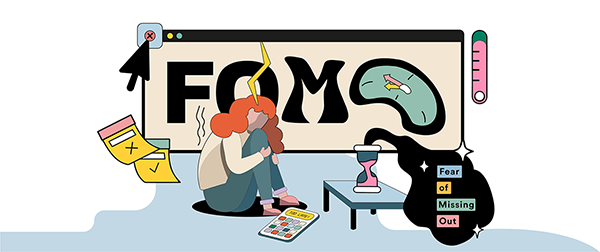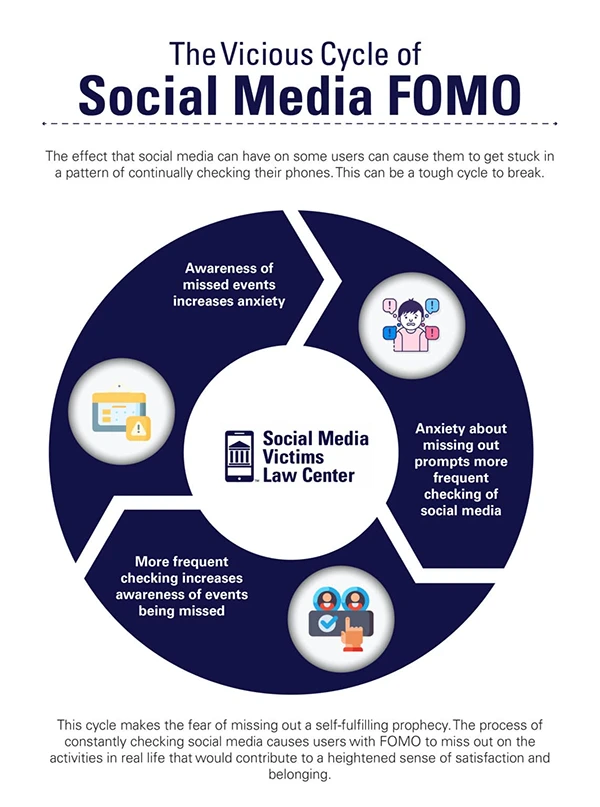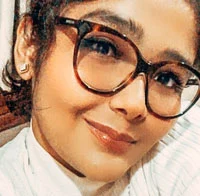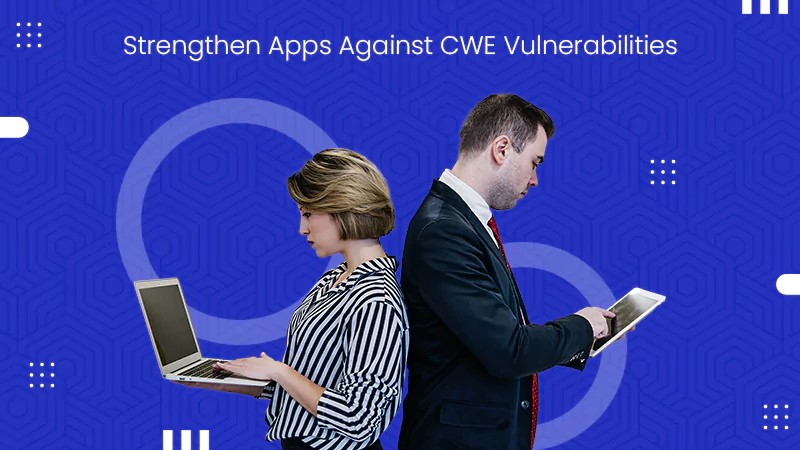FOMO from social media has proven to cause emotional distress.
FOMO Marketing in Social Media and Its Risks on Consumer Mental Health

You must have heard about numerous limited-edition items selling out in seconds, be it a pair of sneakers launched by a famous singer or a specific themed collection from a brand.
The thought of having something only available in the market for a limited period of time is exciting and drives us all to flock to different stores or wait in online queues. And this is exactly how Fear of Missing Out or FOMO marketing works.
60% of shoppers reveal that FOMO was the key influence behind their buying decision. (Leads Crawler: FOMO Statistics)
You see a product trending all across social media, and suddenly you wish you had that, it doesn’t matter if it is actually useful to you or not. The smart marketers, these days, have cracked the FOMO code and are now using it in their favor.
In this post, I will help you understand the psychology of FOMO marketing and its impact on consumers’ mental health.
KEY TAKEAWAYS
- Marketers these days are using the customers’ fear of missing out by promoting limited-time offers and flash sales on social media.
- FOMO marketing can lead to severe consequences, such as financial instability, overspending, and debt.
- It also has a negative effect on mental health and can lead to anxiety, self-doubt, and low self-esteem.
- Brands push the FOMO button by creating urgency through limited-time deals and influencer marketing.
- It is important for both brands and customers to create a balance between engagement and their well-being.
FOMO Marketing – The Engagement Engine
Did you hear about the limited Harry Potter X Miniso collection that was globally launched last month and is not even available in the market anymore? But guess what, I am extremely happy that I could secure a cute Hedwig plushie from the collection. Did I need it? No. Did it cost me a fortune? Yes. Were there other options selling similar products for much lower prices? Yes. So, why did I buy it?
Now that I think about it, the only answer for this could be the Fear of Missing Out (FOMO). My social media feed kept pushing this idea into my mind that everyone around me has something from that unique collection, and the marketers succeeded.
As per Forbes, many social media companies offer advanced targeting options that allow anyone to reach specific demographics. This creates a way to farm increased engagement. The payoff is clear: more likes, shares, and sales, as users jump to stay in the game. It’s a strategy that keeps the algorithm humming and wallets open.
FOMO’s Hidden Cost
Well, some of you might not be realizing the severity of the situation and must be wondering, what is so bad about it? Well, not one, but there are multiple consequences or hidden costs associated with FOMO marketing.
The most severe ones include financial instability from overspending or debts, and a negative impact on productivity and mental health, leading to stress, anxiety, or even burnout.
It doesn’t take long for these consumers to fall into the vicious cycle of social media FOMO and make decisions that they might regret in the future. The infographic below explains this cycle extremely well.

How Brands Push the FOMO Button
As I said before, brands have realized the FOMO concept, and now they are leveraging it in their marketing efforts. Most times this is done in such a subtle way that customers don’t even realize it. Let me tell you about some of the ways brands push the FOMO button to convince customers to spend on their products:
- Creating urgency among customers with limited stocks, time-sensitive deals, exclusive membership, or early access.
- Using influencer marketing tactics to create a trend to make everyone feel like they are missing out on something very basic.
- Providing real-time updates on stock levels, encouraging customers to purchase items before they go out of stock.
- Flash sales or “First 100” offers to create a sense of exclusivity.
- Putting entry deadlines on giveaways and contests.
These tactics work really well in the marketers’ favor, helping them earn more profits. However, for consumers, it can have quite the opposite effects.
Mental Health Risks
The negative impact of social media on mental health is now hidden from none, you can also learn more about it through the Facebook lawsuit. FOMO, when used as a marketing tactic, can have a grave impact on the viewer’s mental health:
- Anxiety and Depression: I think everyone has, at least once, compared themselves with someone living a fulfilling life online.
Most people fail to realize that the things they see through their screen are just a part of someone’s life and not their entire being. This comparison nears the feeling of inadequacy and can lead to anxiety and depression.
- Low Self-Esteem: Seeing others have everything they desire can erode self-esteem and create a feeling of dissatisfaction with one’s own life.
- Jealousy and Envy: Seeing others living the best times of their lives and having everything they want can yield many negative feelings, such as jealousy and anxiety.
Something that might seem like a minor marketing move can lead to such severe effects.
SURPRISING FACT
According to a study by Bankrate, 30% of millennials are willing to go into debt to keep up with friends.
Striking a Balance – Engagement vs. Well-Being
From all that we have discussed above, some of you might have established that FOMO marketing only has its downsides and is probably one of the worst advertising tactics out there. But that is so not true.
If both consumers and marketers learn to strike a balance between engagement and well-being, this strategy can work really well in everyone’s favor. Here is how clients and advertising executives can work collectively to form a healthy marketing environment:
For Consumers: Sometimes it can be really difficult to sit on the other side of the screen and see all the limited-time offers and everyone flaunting their purchases. Knowing when to stop is necessary, stop doomscrolling, and establish screen time limits.
They should also know how to differentiate between the things they actually need and items they only want because of the external pressure or stimuli.
For Brand Owners: Brands should stay as transparent and clear about their offers as possible. By allowing alternatives or extending sales and offers, businesses protect their customers from making impulsive decisions that they might regret later, saving them from resentment and at the same time building trust.
FOMO tactics should be limited to certain aspects only and used in a thoughtful way because nothing is worth sacrificing the customers’ mental health.
Rethinking the FOMO Game
FOMO marketing can prove to be really effective, and it might even yield the desired results, but it also brings various concerns:
- Ethical Concerns: This method of advertising can be classified as manipulative, as it exploits a customer’s fear of missing out, leading to impulsive decisions.
- Short Term Gains: Yes, it can boost short-term sales, but it does not promote healthy long-term relationships between a brand and its clients.
- Negative Brand Perception: Overusing FOMO strategies can make it appear unreliable and untrustworthy, negatively affecting its reputation and losing credibility.
These factors make it essential for brands to rethink their FOMO games and achieve long-term success in a more ethical and customer-favoring manner.
In conclusion, seeing everyone on social media using and promoting specific products of a certain brand is nothing but a way for them to exploit your fear of being left out or missing out on something that is seemingly so common.
FOMO marketing definitely works, but at the same time, its severe consequences are hidden from none. Therefore, brands should use such strategies carefully and responsibly, as their clients’ mental well-being is worth more than any limited-time offer.
Also, customers should look at the bigger picture and know how to differentiate between their needs and wants when shopping from such sales and offers.
Frequently Asked Questions
How does FOMO from social media affect mental health?
What is the effect of FOMO in marketing?
Fear of missing out in marketing encourages or signals the audience to make purchases and seal more deals in a limited time.
What are the negative effects of FOMO?
According to various studies, FOMO can have severe negative effects like fatigue, emotional distress, anxiety, and even depression.
Who is most affected by FOMO?
There are many ways to avoid FOMO on social media, including limiting screen time, deleting your social profiles, or taking a hiatus from social media.
Did you know that in 2024, the Meta company reported 3.35 billion daily active users, and WhatsApp is one among…
Do you know that your modern web app is constantly at risk of being attacked by threats? Every year, attackers…
Creating content can feel like shouting into the void sometimes. You put in all that effort, share your passion, and…
In the fast-paced world of retail, every second counts. Even the famous American businessman, Mickey Drexler, stated, “People like consistency.…
Computer repair is a booming industry with several growth opportunities! The global computer hardware repair service market was valued at…
Are you a marketer? If yes, then you can understand how important insights are for effective advertising, and without them,…
Data loss is a devastating reality for many businesses in 2024! IBM study found that the average total cost of…
Data has emerged as a potent means of facilitating the future of learning in the last few years. In fact,…
Picture this: you’re getting tickets for a sports match, and suddenly, the website crashes, showing “Error 503.” It’s frustrating, right?…






